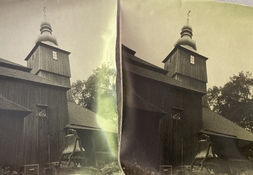AFAIK Bromophen is similar to ID62 which is a general purpose PQ developer. If you add a typical lith developer part A to this, what you basically get is an ID62 variant with a little more hydroquinone. It's not going to make all that much difference vs. just ID62. The main difference will be the dilution; you'd be using the ' augmented Bromophen' a little more dilute than you'd normally do. This would slow down development; combined with the typical lith-print overexposure and 'snatching' the print earlier, what you end up with is a fairly low-contrast print which is likely somewhat warm-toned because of the incomplete development. That seems to be what you got, so nothing really odd going on here. There's no infectious development going on, which would also not be expected given the chemistry - Bromophen is loaded with sulfite and there's phenidone in there, so any potential for lith activity is eliminated.
Talking about the example; I see two prints - what are we looking at here? Is left a reference straight print with normal exposure and right a lith-overexposed, early-snatched print?











